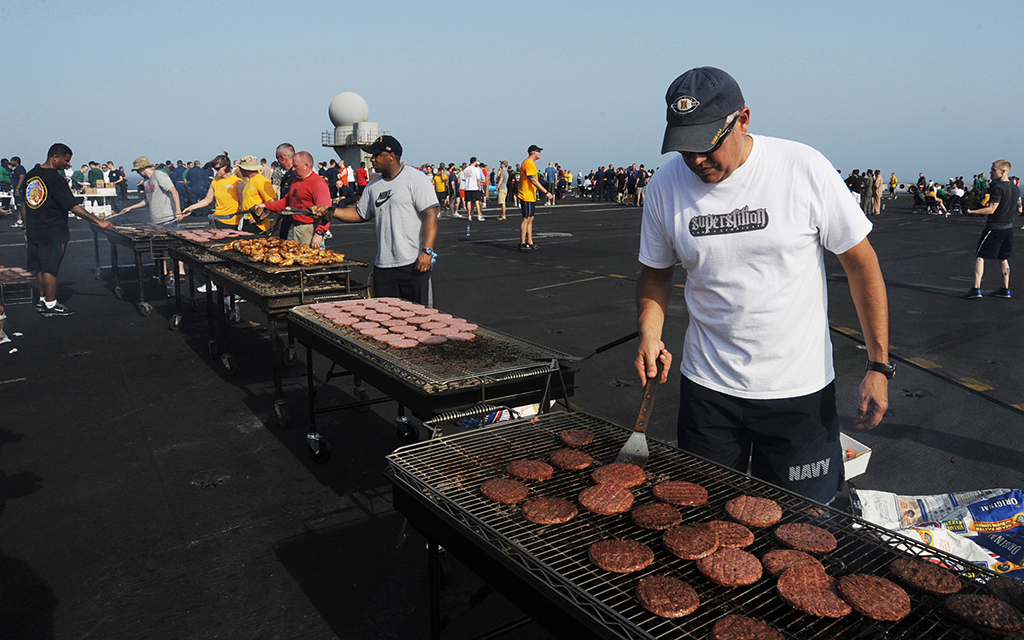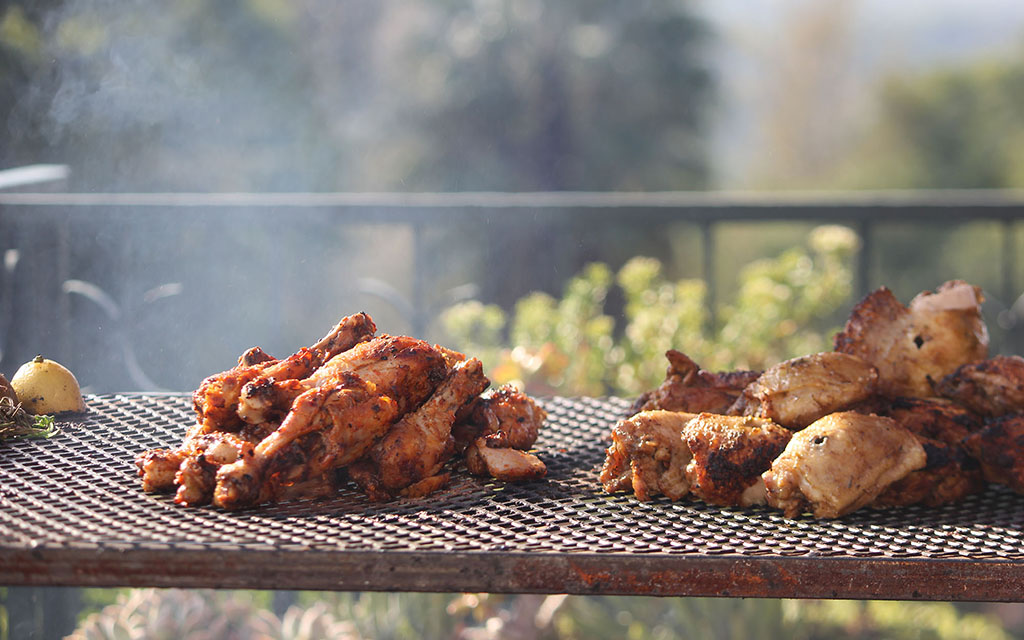
The cost of a July Fourth cookout is down slightly from last year, but prices in 2022 were at an all-time high. This year’s costs are still much higher than two years ago, a survey finds. Members of the aircraft carrier USS Enterprise’s Mustang Association grill for the crew on the flight deck in this 2012 file photo. (Photo by Spc. Gregory White/U.S. Navy)
WASHINGTON – Americans can expect to pay less for their Independence Day cookouts than they did last year but don’t go setting off fireworks over the drop – it’s still 14% higher than two years ago after a historic spike in 2022.
An annual informal survey by the American Farm Bureau Federation said a typical cookout will cost $6.77 per person this year, down from $6.97 in 2022 but well above the 2021 estimate of $5.95.
“I guess the bottom line is that inflation isn’t done,” said farm bureau Chief Economist Roger Cryan.
The informal survey – which relies on volunteers from state farm bureaus to go and price typical cookout items at their local grocery stores – showed increases in beef and processed foods, but drops in the price of chicken, pork and lemonade, among other items.
That’s an improvement over last year when almost every category rose, many by 30% or more. That made 2022 and 2023 the first and second-most expensive years since the survey began in 2013.
Cryan said the report should be taken with a grain of salt – the price of which is not included in the survey – because of its small scale, with just 240 volunteer shoppers participating this year. The real value of the survey, he said, is to focus on the fact that farmers, who face the same inflationary pressures as consumers, don’t “come out as winners from higher prices at the grocery store, either.”
“Farmers are paying higher prices for a lot of their inputs, fuel’s been up and fertilizer, they’ve had some relief in the fertilizer prices but they’re still up from what they were a few years ago,” Cryan said.
Farming is “a tough business,” he said, and it has been particularly tough on cattle ranchers, which is grappling with higher costs and water shortages. That has increased the cost of feed while reducing the number of available cattle.
Lauren Scheller Maehling, the executive director of the Arizona Beef Council, said that problem is especially true in Arizona, where ranchers who depend heavily on seasonal rainfall often have to reduce the number of cattle they can support because of water shortages.
“Arizona is very reflective of what is happening across the country as far as the cost of food and specifically beef prices,” Maehling said. “It’s classic supply and demand. We have a lower supply of cattle in Arizona and across the country and that’s mostly due to drought, reducing the number of cattle across the country.”
Less rainfall means less forage and feed for cattle, which leads to smaller herds and a lower supply of beef, Maehling said. But consumer demand for beef remains high, which drives up prices.
Bill Inman, rancher and owner of the Padres Mesa Demonstration Ranch in northeastern Arizona, worries that the imbalance between supply and demand could hurt consumers.
“We worry about all of that, because if the price gets too high at the farming level because of lack of inventory and high demand and you pass that to the consumer, then the consumer will ease up on their buying,” he said.
Inman, who sells his beef under the Navajo Beef and Native American Beef labels, said the state’s cattle industry is a “complex industry,” made only more challenging by environmental issues and increasingly high costs.
He worries about the impact that recent cuts to Arizona’s share of Colorado River water will have in a state that already lacks enough water to sustain cattle.
“Cattle have to have feed,” Inman said. “I’m not saying people are utilizing water correctly or not correctly, but we are going to have a deficit because of the Colorado River and that means our cattle production is not going to be climbing.”
Maehling said state water reductions could have a long-term effect on costs of feed and on all farming and ranching operations across the state, but seasonal rainfall is the more pressing short-term issue for Arizona ranchers.

While the cost of ground beef is up, prices for chicken and pork chops fell in this year’s American Farm Bureau survey. (Photo courtesy U.S. Embassy South Africa)
“The farmers and ranchers in Arizona mostly rely on the rainfall and that dictates a lot of whether ranchers grow their herd or not,” she said. “The farmers’ and ranchers’ most fickle partner is always Mother Nature and always has been, and will continue to be so.”
Cryan said consumers cruising the grocery aisles should remember that “a lot of that price increase is not going to farmers, and even when it is, farmers are squeezed just like the rest of us with inflation.”
He said the 3% decrease in the farm bureau’s picnic pricing is more optimistic than national data shows: Consumer Price Index data from May showed a 5.8% increase in the cost of food over the last 12 months, which Cryan said is a more accurate measure of the year-to-year change. But he also said the farm bureau predicted higher prices last year than the CPI, so the numbers are about event over the two years.
“If we look at the inflation numbers for food from the government, the increase wasn’t as big a year ago as we showed in our survey and the decrease doesn’t exist at all this year so I think the two-year increase of 14% is pretty much in line with the larger set of numbers,” Cryan said.

